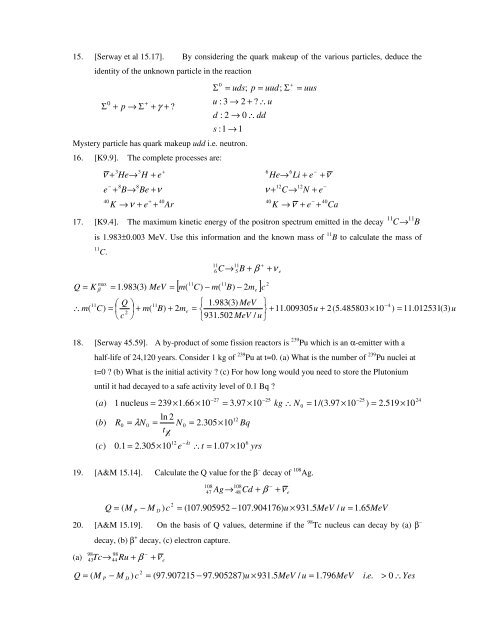Tutorial Answers - School of Physics - The University of New South ...
Tutorial Answers - School of Physics - The University of New South ...
Tutorial Answers - School of Physics - The University of New South ...
Create successful ePaper yourself
Turn your PDF publications into a flip-book with our unique Google optimized e-Paper software.
15. [Serway et al 15.17]. By considering the quark makeup <strong>of</strong> the various particles, deduce the<br />
identity <strong>of</strong> the unknown particle in the reaction<br />
Σ<br />
0<br />
+ p → Σ<br />
+<br />
+ γ + ?<br />
Σ<br />
u<br />
d<br />
0<br />
: 3<br />
= uds;<br />
p = uud;<br />
Σ<br />
: 2<br />
s :1 → 1<br />
Mystery particle has quark makeup udd i.e. neutron.<br />
16. [K9.9]. <strong>The</strong> complete processes are:<br />
3 3<br />
ν + He→<br />
H + e<br />
− 8 8<br />
e + B→<br />
Be + ν<br />
40<br />
K →ν<br />
+ e<br />
+<br />
+<br />
+<br />
40<br />
Ar<br />
→ 2 + ? ∴u<br />
→ 0∴<br />
dd<br />
6<br />
He→<br />
ν +<br />
40<br />
12<br />
+<br />
6<br />
C→<br />
= uus<br />
Li + e<br />
12<br />
−<br />
N + e<br />
−<br />
K →ν<br />
+ e +<br />
17. [K9.4]. <strong>The</strong> maximum kinetic energy <strong>of</strong> the positron spectrum emitted in the decay 11 C→<br />
11 B<br />
Q = K<br />
∴ m(<br />
11<br />
is 1.983±0.003 MeV. Use this information and the known mass <strong>of</strong> 11 B to calculate the mass <strong>of</strong><br />
11 C.<br />
max<br />
β<br />
= 1.983(3) MeV =<br />
⎛ Q ⎞<br />
C)<br />
= ⎜ + m(<br />
2<br />
⎟<br />
⎝ c ⎠<br />
11<br />
B)<br />
+ 2m<br />
11<br />
6<br />
C→<br />
11<br />
5<br />
+<br />
B + β + ν<br />
11<br />
11<br />
[ m(<br />
C)<br />
− m(<br />
B)<br />
− 2me<br />
]<br />
e<br />
c<br />
2<br />
e<br />
+ ν<br />
−<br />
40<br />
Ca<br />
⎧ 1.983(3) MeV ⎫<br />
= ⎨<br />
⎬ + 11.009305u<br />
+ 2(5.485803×<br />
10<br />
⎩931.502<br />
MeV / u ⎭<br />
−4<br />
) = 11.012531(3) u<br />
18. [Serway 45.59]. A by-product <strong>of</strong> some fission reactors is 239 Pu which is an α-emitter with a<br />
half-life <strong>of</strong> 24,120 years. Consider 1 kg <strong>of</strong> 239 Pu at t=0. (a) What is the number <strong>of</strong> 239 Pu nuclei at<br />
t=0 ? (b) What is the initial activity ? (c) For how long would you need to store the Plutonium<br />
until it had decayed to a safe activity level <strong>of</strong> 0.1 Bq ?<br />
( a)<br />
1 nucleus = 239 × 1.66×<br />
10<br />
( b)<br />
( c)<br />
R<br />
0<br />
= λN<br />
0<br />
ln 2<br />
= N<br />
t 1<br />
0.1 = 2.305×<br />
10<br />
2<br />
12<br />
e<br />
0<br />
−27<br />
= 2.305×<br />
10<br />
= 3.97 × 10<br />
12<br />
Bq<br />
∴t<br />
= 1.07 × 10<br />
−λt 6<br />
yrs<br />
−25<br />
kg ∴ N<br />
0<br />
= 1/(3.97 × 10<br />
−25<br />
) = 2.519 × 10<br />
24<br />
19. [A&M 15.14]. Calculate the Q value for the β – decay <strong>of</strong> 108 Ag.<br />
108<br />
47<br />
Ag→<br />
108<br />
48<br />
−<br />
Cd + β + ν<br />
2<br />
Q = ( M P − M D ) c = (107.905952 −107.904176)<br />
u × 931.5MeV<br />
/ u = 1. 65MeV<br />
20. [A&M 15.19]. On the basis <strong>of</strong> Q values, determine if the 98 Tc nucleus can decay by (a) β –<br />
(a)<br />
98<br />
43<br />
decay, (b) β + decay, (c) electron capture.<br />
Tc→<br />
98<br />
44<br />
−<br />
Ru + β + ν<br />
e<br />
2<br />
Q = ( M − M ) c = (97.907215 − 97.905287) u × 931.5MeV<br />
/ u = 1.796MeV<br />
i.<br />
e.<br />
> 0∴Yes<br />
P<br />
D<br />
e
















